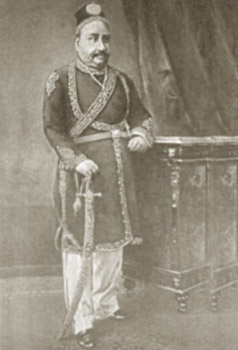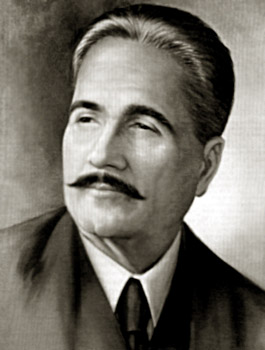 Muslim League, mainly founded by the admirers and followers of Aligarh Movement, was formally founded in Dhaka in the Bengal Presidency in 1906. Its founding members were Nawab Sir Khwaja Salimullah, Nawab Waqar-ul- Kamboh, Nawab Muosin- ul- Mulk and Syed Ameer Ali. The party after independence continued to be a major party in Pakistan but got reduced to a minor party in India. The functioning of Muslim League in India can be traced within three fractions. Initially it came into power just after its foundation in 1906 known as All India Muslim League in British India which finally led to the Partition of India under the leadership of Muhammad Ali Jinnah; the second faction of Muslim League was The Unionist Muslim league, a small autonomous unit of All India Muslim League, mainly functioning in undivided Punjab under the leadership of Sikandar Hayat Khan; and the third faction includes the present day party of Muslim League known as Indian Union Muslim League functioning as a minor political party of Kerala.
Muslim League, mainly founded by the admirers and followers of Aligarh Movement, was formally founded in Dhaka in the Bengal Presidency in 1906. Its founding members were Nawab Sir Khwaja Salimullah, Nawab Waqar-ul- Kamboh, Nawab Muosin- ul- Mulk and Syed Ameer Ali. The party after independence continued to be a major party in Pakistan but got reduced to a minor party in India. The functioning of Muslim League in India can be traced within three fractions. Initially it came into power just after its foundation in 1906 known as All India Muslim League in British India which finally led to the Partition of India under the leadership of Muhammad Ali Jinnah; the second faction of Muslim League was The Unionist Muslim league, a small autonomous unit of All India Muslim League, mainly functioning in undivided Punjab under the leadership of Sikandar Hayat Khan; and the third faction includes the present day party of Muslim League known as Indian Union Muslim League functioning as a minor political party of Kerala.
History of Muslim League
Muslim League as a political party of all the Muslims living in India was mainly formed to answer the discontentment and dissatisfaction that grew among the Muslims. The party which formed a majority in the areas like north western frontier provinces, Baluchistan, Sindh, West Punjab, Kashmir valley and East Bengal, was reduced to a status of minority in India. Their situation got alarmed when a new party of Indian National Congress was formed which after coming to power took no initiative in representing the Muslims living in India. Further the Muslims of India got worried of their status when the British government introduced Hindi as the official language in one of the largest states of united provinces in British India. All this put together forced the Muslims to think, of their representation with a strong ideology.
 With this background the Muslim League was founded on 30th December 1906 with three major aims which included protecting the Muslim interest, to counter the Congress influence and to support the British administration. In India it has been functioning as one of the minority parties especially in Kerala.
With this background the Muslim League was founded on 30th December 1906 with three major aims which included protecting the Muslim interest, to counter the Congress influence and to support the British administration. In India it has been functioning as one of the minority parties especially in Kerala.
Functioning of Muslim League in Three Phases
Muslim League in its first phase was mainly oriented towards the interests of the Muslim community and did not claim for the creation of Pakistan. The initial demand for a separate state of Pakistan was made by Sir Muhammad Iqbal when he differentiated the areas having Muslim majority. The actual demand for a separate state took its form in the second phase of league`s administration under Muhammad Ali Jinnah.
Muslim League played a positive role during the Indian National Movement during which it reiterated its demand for a separate state of Pakistan with a more clear prospective. The League came under tremendous prominence during its Lahore Session in 1940 when it made a formal demand for Pakistan. Along with this, in India, the League came into direct conflict with the Unionist Muslim League under the leadership of Sikandar Hayat Khan. The Unionist Muslim league was mainly functioning as an autonomous unit of All India Muslim League functioning in undivided Punjab.
The third phase emerged after the independence during which the all India party has been reduced into a minority party working mainly in Kerela. The Indian Union Muslim League or the `Muslim League Kerala State Committee` has its roots in the Muslim League of Jinnah; it was founded on March 10, 1948. The party claims to be the political organisation of all Indian Muslims. In 1959, the Indian Union Muslim League participated in the eviction of the first communist government in Kerala. In 1960, the party took part in the establishment of a coalition government in the state. The coalition government comprised the Indian National Congress, Praja Socialist Party and the Indian Union Muslim League. In 1967, the party got into a united front led by the Communist Party of India (Marxist). Communist Party of India, Revolutionary Socialist Party, Karshaka Thozhilali Party (Peasants and Workers Party), Kerala Socialist Party and Samyukta Socialist Party were the other parties in the forefront. After the elections of 1980s the party got disintegrated into two fractions namely united democratic front and left democratic front. While the all India Muslim league joined Left democratic Front, Indian Muslim league joined United Democratic Front. The fractioned groups got reunited in 1985 under the common name of Indian Union Muslim League.
Thus, once a leading democratic party for all the Muslims living in India Muslim league continues to hold a place of prominence even today. Though not so powerful at opposition to Congress which it had maintained during 1940s, in India it now continues to participate in politics by forming a coalition government. The strength of the Muslim League since independence is mainly in Pakistan where All India Muslim league got divided into many more factions namely Pakistan Muslim league (j), Pakistan Muslim League (Jinnah), Pakistan Muslim league (N), Pakistan Muslim league (f), Awami Muslim league and All Pakistan Muslim League (Pervez Musharraf).



















